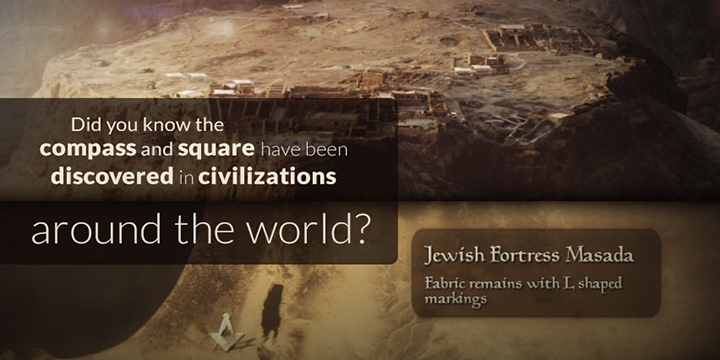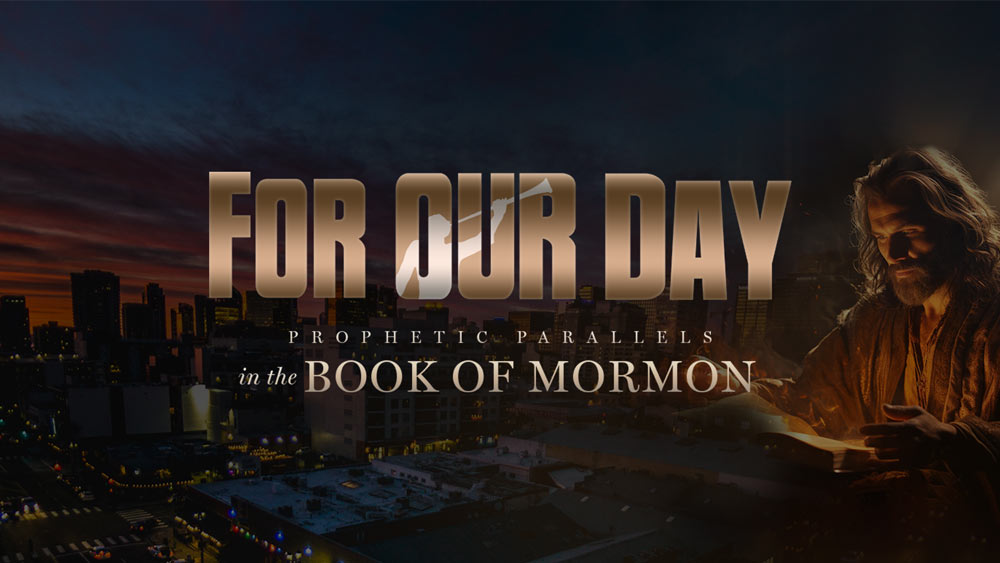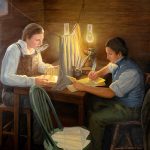Restoration
Vision of Parley P. Pratt
Not long after his baptism in 1830, Parley P. Pratt experienced a remarkable vision.
“I had been on a visit to a singular people called Shakers, at New Lebanon, about seven miles from my aunt Van Cott’s, and was returning that distance, on foot, on a beautiful evening of September.

“The sky was without a cloud; the stars shone out beautifully, and all nature seemed reposing in quiet, as I pursued my solitary way, wrapt in deep meditations on the predictions of the holy prophets; the signs of the times; the approaching advent of the Messiah, to reign on the earth, and the important revelations of the Book of Mormon; my heart filled with gratitude to God that He had opened the eyes of my understanding to receive the truth, and with sorrow for the blindness of those who lightly rejected the same, when my attention was aroused by a sudden appearance of a brilliant light which shone around me, above the brightness of the sun.
“I cast my eyes upward to inquire from whence the light came, when I perceived a long chain of light extended in the heavens, very bright, and of a deep fiery red. It at first stood stationary in a horizontal position; at length bending in the center, the two ends approached each other with a rapid movement, so as to form an exact square. In this position it again remained stationary for some time, perhaps a minute, and then again the ends approached each other with the same rapidity, and again ceased to move, remaining stationary, for perhaps a minute, in the form of a compass; it then commenced a third movement in the same manner, and closed like the closing of a compass, the whole forming a straight line like a chain doubled. It again remained stationary for a minute, and then faded away.
“I fell upon my knees in the street, and thanked the Lord for so marvelous a sign of the coming of the Son of Man. Some persons may smile at this, and say that all these exact movements were by chance; but, for my part, I could as soon believe that the letters of the alphabet would be formed by chance, and be placed so as to spell my name, as to believe that these signs (known only to the wise) could be formed and shown forth by chance. Renewed in spirit and filled with joy I now pursued my way, and arrived at my aunt Van Cott’s, not weary, but refreshed with a long walk, and deep communion with myself and God. 1
First Nauvoo Temple Weathervane
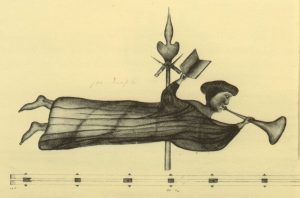 The Nauvoo Temple, unlike many later temples, was designed with a weathervane. The journal of one pioneer man, Perrigrine Sessions, recorded that the weathervane was a “representation of an angel in his priestly robes with a book of Mormon in one hand and a trumpet in the other which [was] over laid with gold” 2. Above this divine messenger was place a stylized tongue of fire and the compass and square.
The Nauvoo Temple, unlike many later temples, was designed with a weathervane. The journal of one pioneer man, Perrigrine Sessions, recorded that the weathervane was a “representation of an angel in his priestly robes with a book of Mormon in one hand and a trumpet in the other which [was] over laid with gold” 2. Above this divine messenger was place a stylized tongue of fire and the compass and square.
Archaeological Discoveries Involving Compass & Square
The compass and square symbols have been discovered at the famous Jewish fortress Masada, at the Bar-Kokhba excavations, in an embankment at Dura-Europos, on a Jewish ossuary from Mt. Scopus and at the Agios Eleftherios Church in Athens, Greece. These sacred emblems have even been identified in the ancient civilization of Egypt on coffins, mummy cases, art and wall paintings. Other discoveries include Jewish tomb reliefs, sarcophagus lids from Palmyra, Syria, and numerous mosaics found in Rome, Ravenna, and Naples.
Ancient Chinese Tapestries
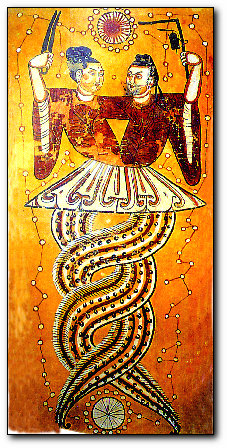 Further information: Fuxi and Nuwa
Further information: Fuxi and Nuwa
There are “veils from Taoist-Buddhist tombs at Astana, in Central Asia, originally Nestorian (Christian) country, discovered by Sir Aurel Stein in 1925… We see the king and queen embracing at their wedding, the king holding the square on high, the queen a compass. As it is explained, the instruments are taking the measurements of the universe, at the founding of a new world and a new age. Above the couple’s head is the sun surrounded by twelve disks, meaning the circle of the year or the navel of the universe. Among the stars depicted, Stein and his assistant identified the Big Dipper alone as clearly discernable. As noted above, the garment draped over the coffin and the veil hung on the wall had the same marks; they were placed on the garment as reminders of personal commitment, while on the veil they represent man’s place in the cosmos.
. . .
In the underground tomb of Fan Yen-Shih, d. A.D. 689, two painted silk veils show the First Ancestors of the Chinese, their entwined serpect bodies rotating around the invisible vertical axis mundi. Fu Hsi holds the set-square and plumb bob … as he rules the four-cornered earth, while his sister-wife Nü-wa holds the compass pointing up, as she rules the circling heavens. The phrase kuci chü is used by modern Chinese to signify “the way things should be, the moral standard”; it literally means the compass and the square.” 3
Another description is found in The Magic Square: Cities in China by Alfred Schinz:
It appears from these legends that civilization, i.e. ordered human life, begins with two personages, both portrayed as being semi-human and with mermaid tails. Nüwa and Fuxi, originally sister and brother, later became wife and husband after they had invented proper marriage procedures and family names to prevent marriages between people from the same family. Nüwa, in her own legend, had restored order between heaven and earth after a horrible catastrophe had caused heaven to tilt to the north so that it no longer covered all of the earth. This may refer to the first observation of the oblique elliptic and the angle of the pole star. Nüwa found it necessary to reestablish the four cardinal points, which she did, thereby creating the prerequisites for further observations. In the oldest pictures of her she carries a compass, the instrument related to heavenly observations. Her brother Fuxi became the first legendary emperor, which also implies the establishment of government, of law and order… On another, more practical level he is said to have invented axes for splitting wood, the carpenter’s square, ropes for hunting and fishing nets. It is worthy of special attention that the two words for compass and square, gui ju, used together denote -the rule, custom, usage- and -good behavior-, i.e., keeping order. Furthermore, it should be observed that the male-female system, the yang-yin philosophy, is expressed here in a complex manner, first as Fuxi and Nüwa, second as compass (male) and square (female), and third as Nüwa (female) with compass (male) and Fuxi (male) with square (female). The compass-square dichotomy is similar to the heaven-earth, yang-yin, relationship, which in this case means that man (Fuxi) establishes harmonious order between heaven and earth. This is also expressed in the Chinese character for king, wang, the upper and lower line indicating heaven and earth and the middle line man, all three connected by the vertical line. This represents the position and function of the ruler; it is he who establishes and keeps order by placing himself in a balanced and harmonious position between heaven and earth, so that yang and yin cooperate in a beneficial way.
[Caption] Fuxi and his sister Nüwa, he with the carpenter’s square and she with the pair of compasses. From the decoration incised in the wall of the Wu Lang tombs in Jiaxiang, Shandong, second century AD. The Chinese words for carpenter’s square, ju, and a pair of compasses, gui, together form the expression to establish order. This is what, according to their legends, Fuxi and Nüwa did. The carpenter’s square also stands for the square that is the symbol of the earth, while the pair of compasses represent the circle, the symbol of heaven. Fuxi, the male (yang), gives order to the earth (yin), and Nüwa, the female (yin), gives order to the heaven (yang). 4
Other historians on the Fu Xi ans Nuwa symbols:
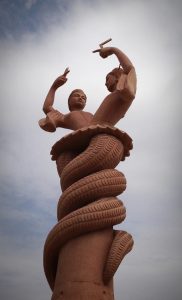
“In Chinese cosmogonic art during the Han Dynasty (206 B.C.E.–220 C.E.) two royal creator deities were depicted holding architectural implements that were used in the formation of heaven and earth—the compass and set-square (see Yves Bonnefoy, comp., Asian Mythologies [Chicago: University of Chicago Press, 1993], 234–35). In a funerary context these beings served as “doorkeepers” or “guardians of boundaries” who “marked the division between inner and outer” spaces (cf. Gen. 3:24; Ex. 26:31). The depiction of these deities signified “transfer to another realm.” As early as the Warring States Period (475–221 B.C.E.) the Chinese compass and square “symbolized fixed standards and rules that impose order on unruly matter.” The Chinese deity who was shown holding the compass was associated with bringing “ordered space out of the chaos of the flood” (cf. the Hebrew concept) while the other, who held the square, was “’credited with the invention of kingship’” 5
“In traditional Chinese cosmology the earth was square and the heavens round and thus Fuxi holds a set square to draw the former, and Nüwa a pair of compasses to draw the circle of the earth.” 6
“This role of linking Heaven to Earth also figures in the depictions of Fu Xi and Nü Wa. First, in Han tombs their elongated, serpent bodies stretch from the bottom of the register to the top, and in later depictions this vertical ascent becomes even clearer. In Sichuan sarcophagi they play the iconographic role of the dragons on the Mawangdui banners who physically link the earthly realm to that of Heaven. This idea is reinforced through the regular inclusion of two other iconogrpahic traits. Fu Xi and Nü Wa are often depicted with the sun and moon, and they are shown holding a carpenters square (Fu Xi) and a drawing compass (Nü Wa). The former are metonyms for Heaven and the celestial equivalents of yin and yang. The latter suggests the linking of square Earth to the round Heaven. Most scholars agree that the role of the intertwined Fu Xi and Nü Wa was to depict the interaction of yin and yang that underlies cosmic order and thereby secure an auspicious environment for the denizen of the tomb.” 7
“The Chinese picture illustrates in true archaic spirit (which means that only hints are given, and the spectator has to work out for himself the significance of the details) the surveying of the universe. The two characters surrounded by constellations are Fu Hsi and Nu Kua, i.e., the craftsman god and his paredra, who measure the “squareness of the earth” and the “roundness of heaven” with their implements, the square with the plumb bob hanging from it, and the compass. The intertwined serpent-like bodies of the deities indicate clearly enough, although in a peculiar “projection,” circular orbits intersecting each other at regular intervals.” 8
“All “great instruments” were invented by the ancients to help lesser men “first rule the self and then rule others.” Although all are needed in construction, by no means do all these tools work in the same way. Level and line determine straight horizontal and vertical lines, while compass and square are needed to form perfect circles and corners. By analogy, each of the social institutions, including ritual, has its own function in building civilization, with each addressing a separate human need. It is characteristic of the sage-ruler that he always knows which tool to apply to the specific problem at hand. 9
Jewish
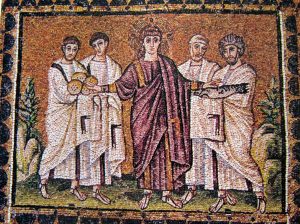 Among the textile fragments excavated at Masada were the remains of pieces of fabric with L-shaped cloth markings affixed to them. Dating to before A.D. 73, these are among the very earliest known examples of such marked garments. . . . Because these markings seem to appear artistically in conjunction with some hope for life or glory after death, their presence on the clothing found at Masada may reflect something about the religious hopes and convictions of the Jewish fighters who died there. 10
Among the textile fragments excavated at Masada were the remains of pieces of fabric with L-shaped cloth markings affixed to them. Dating to before A.D. 73, these are among the very earliest known examples of such marked garments. . . . Because these markings seem to appear artistically in conjunction with some hope for life or glory after death, their presence on the clothing found at Masada may reflect something about the religious hopes and convictions of the Jewish fighters who died there. 10
Gammadia Marks
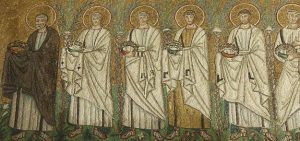 “Scholars refer to these markings as gammadia, some of them being shaped like the Greek letter gamma (G). Though similar patterns have been found in several locations, the significance of these markings remains unknown to archaeologists and art historians.” 11
“Scholars refer to these markings as gammadia, some of them being shaped like the Greek letter gamma (G). Though similar patterns have been found in several locations, the significance of these markings remains unknown to archaeologists and art historians.” 11
“The Greek word translated as ‘infallible proofs’ in Acts 1:3 is a derivative of tekmerion which means ‘a sure sign,’ ‘a mark,’ ‘a token’.” 12
Egypt
When the Egyptian embalming priests of the 30th Dynasty wrapped the corpse in the many yards of linen cloth, they included various amulets (A) to protect and strengthen the deceased. Located over the heart were two miniature tools, the square (B) and the compass-like horizontal level (C). An actual working example of a wooden A-frame with a plumb bob suspended from its apex (D) was found in the tomb of Sennedjem, c. 1220 B. C. About the time of Christ, these same symbolic tools were included in the list of amulets carved in the Osiris chapel on the temple roof at Dendera. 13
- Autobiography of Parley P. Pratt, p. 31
- Perrigrine Sessions Journal, 30 Jan 1846, Church Archives
- Temple and Cosmos, Hugh Nibley, pg. 111-115
- Schinz, The Magic Square: Cities in Ancient China, 25-26
- Mark E. Lewis, The Flood Myths of Early China, Albany: State University of New York Press, 2006], 125–27
- Whitfield and Sims-williams, The Silk Road, 329, link
- Lewis, Writing and Authority in Early China, 204, link
- Giorgio De Santillana, Hertha Von Dechend, Hamlet’s Mill, 272, link
- Yan Hsiuing, Xiong Yang, Michael Nylan, The Elemental Changes: The Ancient Chinese Companion, 54, link
- BYU Studies (1996-7), 251-8, John W. Welch and Claire Foley
- Gammadia on Early Jewish and Christian Garments
- All Things Restored, p. xiii, footnote #11. He uses Vine’s Complete Expository Dictionary of Old and New Testament Words and The New Strong’s Exhaustive Concordance of the Bible.
- Temple and Cosmos, p. 112-113.

